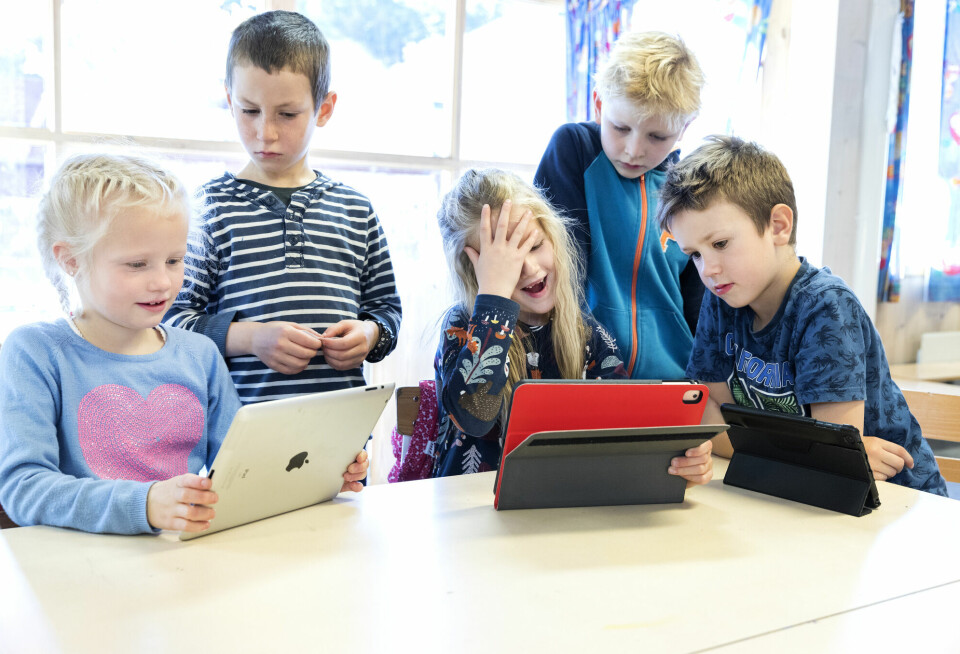
Student survey: Reading comprehension is better on paper than on screens
It is important that screen use in school does not replace reading in print, according to the Norwegian Screen Use Committee, in its first memorandum to the government.
Poor reading skills among Norwegian children made headlines and created debate when the latest results from the PISA survey were published in the autumn of 2023.
The number of Norwegian pupils reading at a low-performing level has risen from 19 per cent in 2018 to 27 per cent in 2022.
This means that "more than one in four Norwegian 15-year-olds reads at such a low level that they may encounter problems in further education and in the workforce,' lems in further schooling and in working life," according to the Screen Use Committee’s first memorandum to the government.
The increase might partly be due to the pandemic.
But could the prevalence of screens in schools also have something to do with it?
Most viewed
The committee believes that it might. After reviewing the available research on screen use and reading, they write:
"A preliminary conclusion from the committee is that there is much to suggest that students should read more on paper."
Rapid and significant change in schools
The Screen Use Committee was established in the summer of 2023 and will submit its final recommendations in November 2024. Former Oslo City Council member Robert Steen has assembled a team of nine professors and researchers in the field. Together, they aim to determine what we know and what we don't know on the topic.
Almost all Norwegian children have access to their own screen in school, according to figures from the Norwegian Directorate for Education (link in Norwegian).
The introduction of screens in classrooms has happened quickly, and represents a significant change in Norwegian classrooms, according to the Screen Use Committee.
So it is perhaps not so surprising that the debate over screen use in schools has been raging in recent years. In January 2023, concerned parents started a petition for reduced screen use in primary schools. The petition evolved into a Facebook group, which currently has over 21,000 members, including well-known actors and authors. The group has demonstrated in front of the Norwegian Parliament and submitted demands to the Minister of Education at the time, Tonje Brenna.
The digitisation around our childreen has been a bit unconscious in recent years, Brenna said when she met petitioning parents with the tabloid newspaper VG present (link in Norwegian).
The Screen Use Committee reports that research in the field is falling behind and provides minimal insight into long-term consequences. In many areas, the results differ. Studies are conducted on different age groups and do not always measure the same things. In one area, however, much points in the same direction.
Better reading comprehension on paper
"Studies show that pupils in primary education and students in higher education have poorer reading comprehension after reading a text on a screen compared to on paper," the committee writes in their memorandum.
Both meta-analyses – where researchers gather data from several studies – and a knowledge summary conclude that reading on paper provides better reading comprehension of longer and more complex texts than reading the same text on a screen.
The committee also highlighted individual studies.
The reading comprehension of Norwegian ten-year-olds used to be assessed on paper. Now, these national reading tests are conducted digitally. In the transition from a paper to a digital test, researchers ran an experiment to measure the effect of taking the reading test digitally or on paper. Over a thousand pupils in grade 5 from all over Norway participated. Almost a third of the students performed better when they read on paper compared to a screen.
We read faster on a screen, but absorb less of what we read. Scrolling is demanding, and the screen offers a plethora of distractions, according to the researchers.
Does screen use lead to reading shorter texts?
Screens especially affect the reading of long texts. Several studies find no difference when looking at short texts.
The Screen Use Committee is concerned about whether the increased use of screens in school could lead to reading shorter texts at the cost of longer texts.
"It's highly uncertain whether children and young people today get enough time to develop the ability to read in depth," they write.
The reading surveys in recent years have shown not only that reading skills among Norwegian pupils are declining. They also show that fewer pupils read in their free time now, and that Norwegian pupils read fewer long texts than their peers in the other Nordic countries.
The committee points out that these findings are worrisome, because reading long texts is not only important for developing good reading skills, but also for developing skills like critical thinking.
People of all ages read poorly on screens
The researchers found that the negative effect of reading on a screen is the same across all age groups.
"How much experience you have reading on a screen does not seem to influence how well you read on a screen," the committee writes.
What does affect it, however, is reading skills. For proficient readers, it matters less whether they read on a screen or paper.
Poor readers struggle more with reading on a screen, although the screen can offer these readers opportunities that the paper format cannot provide, the committee points out. They conclude that "the discussion about screens and reading should involve making informed choices regarding when pupils should read digitally and when they should read on paper."
Keyboard or pencil
Primary and secondary schools use screens mostly for writing. The research that has compared writing by hand and typing on a keyboard has mostly focused on young children who are learning to write.
The Norwegian project DigiHand found no difference in learning to write by hand or with a keyboard in two studies of first graders.
But the committee points out that studies like this have only looked at a specific time period. We still know little about how development is impacted over time and what it may mean for pupils' cognitive abilities in the long term.
Typing on a keyboard can help someone who is less skilled at writing by hand to write more. This can be motivating.
But writing by hand activates the brain in a different way than typing on a keyboard. Writing by hand trains fine motor skills and is associated with the development of various cognitive skills.
The committee's preliminary conclusion is that school policy must facilitate giving both handwriting and keyboards a natural place in teaching.
What does ‘more’ mean?
Øystein Gilje is a professor at the University of Oslo's Department of Teacher Education and School Research. He has spent many hours observing what happens in the classrooms of Norwegian schools.
He believes the committee has submitted a good, balanced first memorandum.
“This memorandum is important because it brings nuance to the purpose of reading and the diverse types of texts that we encounter in different subject areas,” Gilje says.
But there is a small caveat.
“The memorandum lacks research showing how much reading pupils do on paper or screen in Norwegian schools today, so it’s difficult to know what ‘more’ means. If the researchers conclude that students should read more on paper, it should also be specified when in the educational process this is most important and for what purpose. I expect that to become clearer in a later report,” he says.
In its further work, the committee will look at how both printed and digital learning materials have developed over time. Is it the case, for example, that learning materials and resources have become more limited and use more images, sound, and video now?
“These are fundamental questions in a learning environment where students have many different approaches to knowledge,” Gilje says.
“It raises the question of whether we can say that reading is the only gateway to learning in the same way as before. This doesn’t mean that reading and learning to read at a good level are not important. But in today's society, a lot can be learned through completely different forms of expression than writing alone.”
A wise recommendation
Professor Marte Blikstad-Balas thinks recommending that pupils do more reading on paper is wise and important.
“Digitisation has progressed rapidly in many schools, and we know that pupils both now and in the future need to be able to read well on paper and on screen. We have to ensure that they read enough in both of these formats. In some schools, this will involve more paper than today," she says.
Blikstad-Balas, whose research includes reading, writing, and digital media at the University of Oslo, does not believe that digitisation alone can explain why an increasing number of Norwegian students struggle with reading skills.
“But I certainly believe that the rapid digitisation is part of the explanation. Especially if we also include the dramatic increase in screen use during students' free time in the equation,” she says.
The Screen Use Committee's work is important, believes Blikstad-Balas, who also hopes that the committee succeeds in problematising its own name and mandate.
"Discussing screen use as if it's a singular, consistent activity with predictable outcomes, regardless of context, is challenging. The committee members are aware of this. Therefore, I hope their efforts to bring nuance are recognised in the broader, often polarised public debate about screen use," she says.
Reference:
Konsekvenser av skjerm i skolen – et kunnskapsgrunnlag fra skjermbrukutvalget (Consequences of screens in schools – a knowledge base from the Screen Use Committee), Screen Use Committee, 2023.
———
Translated by Ingrid P. Nuse







































